
Floriana, also known by its title Borgo Vilhena, is a fortified town in the South Eastern Region area of Malta, just outside the capital city Valletta. It has a population of 2,205 as of March 2014. Floriana is the birthplace of many famous Maltese, amongst which the composer of the national anthem, 'L-Innu Malti', Robert Samut; former Bishop of Malta Dun Mauro Caruana, the poets Oliver Friggieri and Maria Grech Ganado, the writer and politician Herbert Ganado and Swedish Idol winner Kevin Borg.

Victoria, also known among the native Maltese as Rabat or by its title Città Victoria, is an administrative unit of Malta, the largest and most prominent city of Gozo,. Victoria has a total population of 6,901, and by population, is the largest locality in Gozo.

Żurrieq is a town in the Southern Region of Malta. It is one of the oldest towns in the country, and it has a population of 11,823 inhabitants as of March 2014. Żurrieq is one of the 10 parishes to be documented in 1436 and it is dedicated to Saint Catherine. The island of Filfla is administratively a part of the town. The town stretches from Nigret to Ħal Far. In old times the town was had a border with Żejtun. The village of Qrendi used to be part of the parish of Żurrieq until 1618 when it was made into its own parish.

St John's Co-Cathedral is a Roman Catholic co-cathedral in Valletta, Malta, dedicated to Saint John the Baptist. It was built by the Order of St. John between 1572 and 1577, having been commissioned by Grand Master Jean de la Cassière as the Conventual Church of Saint John.
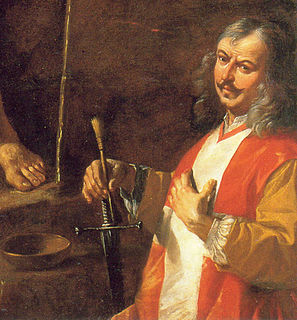
Mattia Preti was an Italian Baroque artist who worked in Italy and Malta. He was appointed a Member of the Order of Saint John.

St Francis of Assisi Church, dedicated to St Francis of Assisi, in Valletta, was built in 1598 and was completed by 1607.

St Augustine Church is one of the churches built during the creation of the new city of Valletta, Malta.

The Metropolitan Cathedral of Saint Paul, commonly known as St Paul's Cathedral or the Mdina Cathedral, is a Roman Catholic cathedral in Mdina, Malta, dedicated to St. Paul the Apostle. The cathedral was founded in the 12th century, and according to tradition it stands on the site of where Roman governor Publius met St. Paul following his shipwreck on Malta. The original cathedral was severely damaged in the 1693 Sicily earthquake, so it was dismantled and rebuilt in the Baroque style to a design of the Maltese architect Lorenzo Gafà between 1696 and 1705. The cathedral is regarded as Gafà's masterpiece.
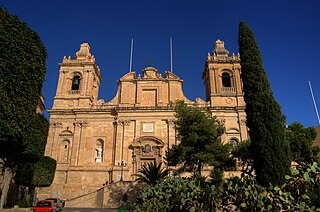
The Collegiate church of Saint Lawrence is an old Church situated in Birgu in Malta.

The Church of St Nicholas is the Roman Catholic parish church of Siġġiewi, Malta, dedicated to Nicholas of Bari. It was built in the late 17th century and it took over the function of an older parish church which was located elsewhere in the village and which now lies in ruins.

The Church of St Catherine of Alexandria, commonly known as the Church of St Catherine of Italy is a Roman Catholic church in Valletta, Malta. It was built by the Hospitaller Langue of Italy and it serves as the parish church of the Italian community of Malta.

The Church of St Barbara is a Roman Catholic church situated in Valletta, Malta. The church was built to service the spiritual needs of the knights of Provence.

The Church of St Catherine is a Roman Catholic parish church that serves the village of Żurrieq.

The Collegiate Church of the Immaculate Conception is a Roman Catholic parish church located in Cospicua, Malta.

The Church of St George is a 16th-century baroque Roman Catholic parish church located in Qormi, Malta.
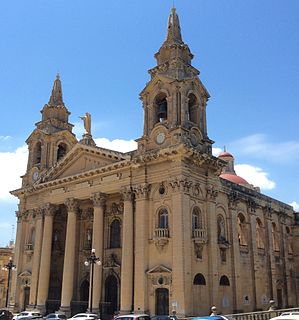
The Saint Publius Parish Church, also known as the Floriana Parish Church is a Roman Catholic parish church in Floriana, Malta, dedicated to Saint Publius. It was constructed at several stages between the 18th and 20th centuries.

The 1813–1814 Malta plague epidemic was the last major outbreak of plague on the islands of Malta and Gozo. It occurred between March 1813 and January 1814 on Malta and between February and May 1814 on Gozo, and the epidemic was officially declared to be over in September 1814. It resulted in approximately 4500 deaths, which was about 5% of the islands' population.
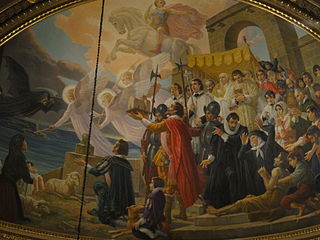
The 1675–1676 Malta plague epidemic was a major outbreak of plague on the island of Malta, then ruled by the Order of St John. It occurred between December 1675 and August 1676, and it resulted in approximately 11,300 deaths, making it the deadliest epidemic in Maltese history. Most deaths were in the urban areas, including the capital Valletta and the Three Cities, which had a mortality rate of about 41%. In the rural settlements, the mortality rate was 6.9%.

The Church of Our Lady of Sorrows is a Roman Catholic church in Pietà, Malta. It was established in the late 16th or early 17th century near a cemetery in which victims of the 1592–1593 Malta plague epidemic were buried. It was originally dedicated to Saint Roch, but after a convent was built next to it in the early 17th century it was rededicated to Our Lady of Sorrows. The church later gave its name to the town of Pietà which developed nearby, and the present building dates back to the mid-18th century when it was reconstructed. Both the church and the convent are currently in the hands of a Catholic youth ministry.
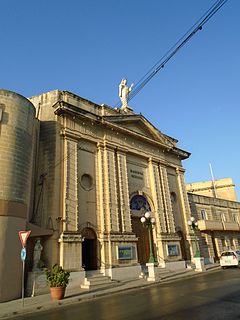
The Parish Church of the Immaculate Conception of Our Lady is a Roman Catholic parish church in Ħamrun, Malta. It was built between 1958 and 1963 and it took over the role of an oratory dedicated to the Immaculate Conception which had been established in Ħamrun in 1923. It has been a parish church since 1968.





















